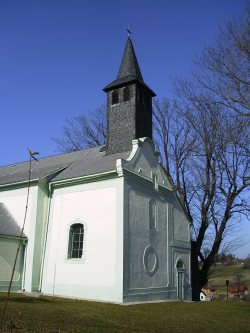DLOUHÁ VES | Mikroregion Šumava Západ
Menu
Menu
Levý sloupec - Dlouhá Ves
Contact
Ing. Jaroslav Tachovský
Chairman of the Coordinating Council
Modrava 63
341 92 Kašperské Hory
E-mail: mikroregion@sumavanet.cz
Tel. : +420 602 680 178
Dlouhá Ves
Dlouhá Ves – villages of Annín, Janovice, Platoř, Bohdašice, Nové Městečko, Rajsko as part of the cadastral community
TopographyThe village of Dlouhá Ves is situated in Plzeň (Pilsen) Region, Klatovy District, beyond the right bank of the Otava River, near the road from Sušice to Kašperské Hory. It lies in the altitude of 512 meters above see level.
Latitude: 49° 11’ 38’’
Longitude: 13° 30’ 6’’
Population: 811
Dlouhá Ves – the valley of glass beauty and wooden bread
 Probably since the 13th century already, Dlouhá Ves formed the centre of the manor, whose owners called themselves in accordance therewith as Dlouhoveští of Dlouhá Ves. They resided in a fortress with the origins dating back to the 13th century too. The name of the village was the most probably derived from the form of built-up area along the ancient road from Sušice through Tuškov to Kašperské Hory. The first written record documenting its existence comes from 1290.
Probably since the 13th century already, Dlouhá Ves formed the centre of the manor, whose owners called themselves in accordance therewith as Dlouhoveští of Dlouhá Ves. They resided in a fortress with the origins dating back to the 13th century too. The name of the village was the most probably derived from the form of built-up area along the ancient road from Sušice through Tuškov to Kašperské Hory. The first written record documenting its existence comes from 1290.
The first noted owner of Dlouhá Ves was Blajislav denoted with the predicative "de Longa Villa", meaning "of Dlouhá Ves". Historically he has been considered the founder of the family of Dlouhoveští who were holding the manor till the end of the 15th century. The descendants of this branched family have been living in the Náchod region to date.
In 1470 the family of Dlouhoveští sold Dlouhá Ves. Many owners have occurred there since, starting with Tomek of Čejkovy up to the Czech family Bubnové z Litic. In 1697 Jan Jiří Schumann together with his wife Anna Dorothea purchased the manor, after which Dlouhá Ves transformed entirely. The ancient knightly fortress was rebuilt into the Baroque dipteral manor house connected with with the château Chapel of the Holy Cross. The Gothic church built in 1368 was adapted too - it was extended by two Baroque chapels and a bell was bought for the church in 1710. Both Jan Jiří Schumann and his wife are buried in this church. The Schumanns gained recognition for development of Dlouhá Ves, nevertheless paid high price for it and eventually they had to sell the indebted property. In 1787 the property was held by Josef Enis who sold it to Jan Josef Schwarzenberg. The Schwarzenbergs later united Dlouhá Ves with their manor in Prášily.
This nevertheless factually ended up the independence of the manor of Dlouhá Ves. Since this merger the manor has been a part of the Schwarzenbergs' estates in south-west Bohemia. The Schwarzenbergs kept Dlouhá Ves until 1930. They founded Nová Dlouhá Ves, where they built 22 new gable houses for their employees in the south direction along the new road to Kašperské Hory, they established a saw-mill and a raft binding-place.
We should also mention Jewish tradesmen who have been settling down in Dlouhá Ves since the mid-18th century, with leather and flax being their best selling article. Thirty seven Jewish families settled down in the area between the manor-house and the church, where they also founded a small synagogue and a cemetery. In 1937 the synagogue burnt up and was razed to the ground. The old Jewish cemetery with the tombstones from the 18th and 19th centuries has nevertheless survived to date (about 300m to the south-east of the church).
The manor-house with the chapel started to become desolate after 1930, when the Schwarzenbergs lost the property of Dlouhá Ves. During the World War II the manor building served as a dormitory of French war prisoners. The premises of the manor-house burnt up in 1949, with just a fragment of the chapel remaining thereafter. This was definitely liquidated in May 1984. In the site of the former manor-house there is only the Dlouhá Ves Šumava farmstead. The era of local noble inhabitants is evoked only by the old fountain in centre of the farm.


